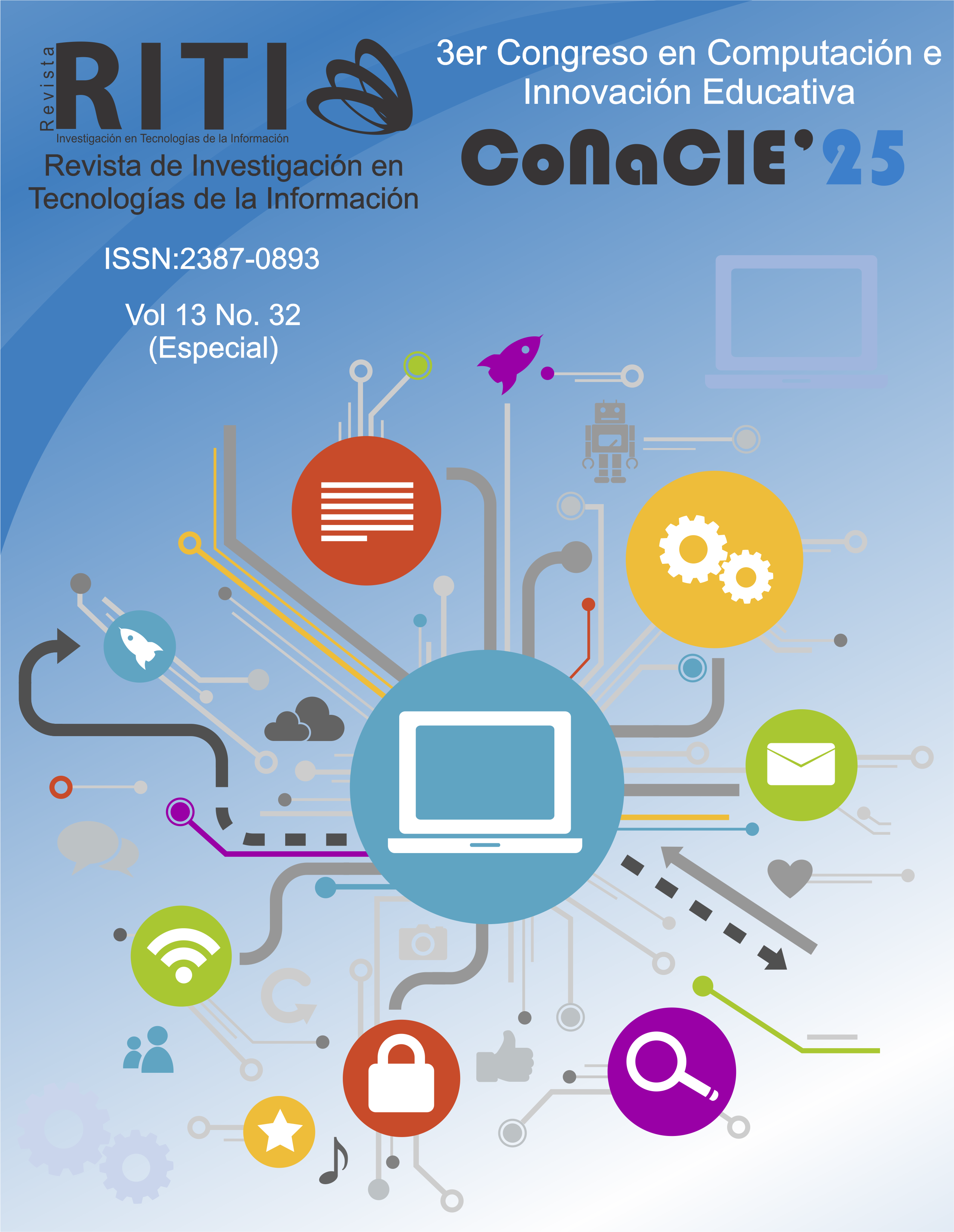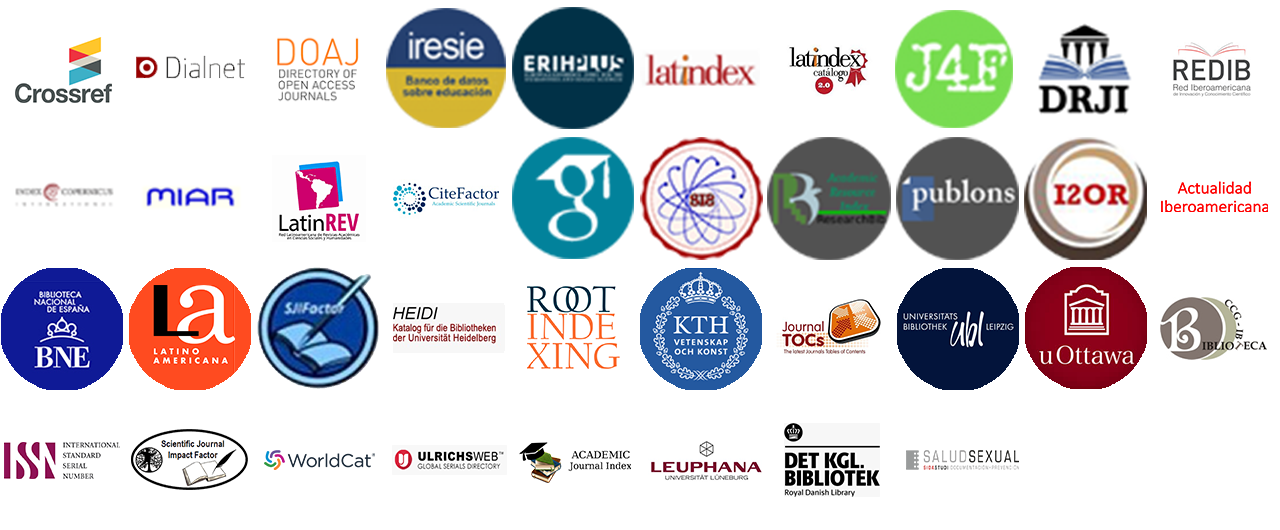Convolutional neural network for estimating soil gravimetric moisture using UAV multispectral bands
DOI:
https://doi.org/10.36825/RITI.13.32.004Keywords:
Convolutional Neural Networks, Multispectral UAV, Gravimetric Moisture, Precision Agriculture, Water ManagementAbstract
Accurate estimation of soil gravimetric moisture is essential for the efficient management of water resources in precision agriculture, particularly in semi-arid regions. This study proposes a convolutional neural network (CNN) to estimate soil gravimetric moisture using multispectral data acquired by unmanned aerial vehicles (UAVs). The research was conducted on a clay-loam soil plot in Guasave, Sinaloa, Mexico, during different post-irrigation drying phases. A DJI Mavic 3 Multispectral drone equipped with sensors in the Green (560 nm), Red (650 nm), Red-Edge (730 nm), and NIR (860 nm) bands was employed, capturing imagery with a spatial resolution of approximately 4 cm/pixel. In situ gravimetric measurements were collected to validate the performance of the developed CNN model. The proposed CNN architecture consisted of three Conv1D layers with 32 filters, one MaxPooling layer, a flattening layer, and a fully connected dense layer, specifically designed to capture complex nonlinear relationships between spectral bands and soil moisture. The model achieved outstanding performance, with a mean squared error (MSE) of 0.0058, a coefficient of determination (R²) of 0.91, and a mean absolute error (MAE) of 0.046 on the test dataset. Predictions were highly correlated with actual measurements (r = 0.92, p < 0.001). Statistical analyses confirmed homoscedasticity and residual normality, indicating model robustness. Furthermore, the CNN-based approach outperformed traditional empirical indices, demonstrating high sensitivity to within-field microvariability.
References
Rosegrant, M. W., Ringler, C., Zhu, T. (2009). Water for Agriculture: Maintaining Food Security under Growing Scarcity. Annual Review of Environment and Resources, 34 (1), 205–222. https://doi.org/10.1146/annurev.environ.030308.090351
Qian, Y., Zhu, Y., Ye, M., Huang, J., Wu, J. (2021). Experiment and numerical simulation for designing layout parameters of subsurface drainage pipes in arid agricultural areas. Agricultural Water Management, 243. https://doi.org/10.1016/j.agwat.2020.106455
Wisser, D., Frolking, S., Douglas, E. M., Fekete, B. M., Vörösmarty, C. J., Schumann, A. H. (2008). Global irrigation water demand: Variability and uncertainties arising from agricultural and climate data sets. Geophysical Research Letters, 35 (24), 1-5. https://doi.org/10.1029/2008GL035296
Dorigo, W., Himmelbauer, I., Aberer, D., Schremmer, L., Petrakovic, I., Zappa, L., Preimesberger, W., Xaver, A., Annor, F., Ardö, J., Baldocchi, D., Bitelli, M., Blöschl, G., Bogena, H., Brocca, L., Calvet, J.-C., Camarero, J. J., Capello, G., Choi, M., … Sabia, R. (2021). The International Soil Moisture Network: serving Earth system science for over a decade. Hydrology and Earth System Sciences, 25 (11), 5749–5804. https://doi.org/10.5194/hess-25-5749-2021
Katz, B. S., Stotler, R. L., Hirmas, D., Ludvigson, G., Smith, J. J., Whittemore, D. O. (2016). Geochemical Recharge Estimation and the Effects of a Declining Water Table. Vadose Zone Journal, 15 (10), 1–13. https://doi.org/10.2136/vzj2016.04.0031
Beck, H. E., Pan, M., Miralles, D. G., Reichle, R. H., Dorigo, W. A., Hahn, S., Sheffield, J., Karthikeyan, L., Balsamo, G., Parinussa, R. M., Van Dijk, A. I. J. M., Du, J., Kimball, J. S., Vergopolan, N., Wood, E. F. (2021). Evaluation of 18 satellite- and model-based soil moisture products using in situ measurements from 826 sensors. Hydrology and Earth System Sciences, 25 (1), 17–40. https://doi.org/10.5194/hess-25-17-2021
Harpold, A. A., Kaplan, M. L., Klos, P. Z., Link, T., McNamara, J. P., Rajagopal, S., Schumer, R., Steele, C. M. (2017). Rain or snow: hydrologic processes, observations, prediction, and research needs. Hydrology and Earth System Sciences, 21 (1), 1–22. https://doi.org/10.5194/hess-21-1-2017
Kerr, Y. H., Al-Yaari, A., Rodriguez-Fernandez, N., Parrens, M., Molero, B., Leroux, D., Bircher, S., Mahmoodi, A., Mialon, A., Richaume, P., Delwart, S., Al Bitar, A., Pellarin, T., Bindlish, R., Jackson, T. J., Rüdiger, C., Waldteufel, P., Mecklenburg, S., Wigneron, J.-P. (2016). Overview of SMOS performance in terms of global soil moisture monitoring after six years in operation. Remote Sensing of Environment, 180, 40–63. https://doi.org/10.1016/j.rse.2016.02.042
Rand, C. F., Khan, A. L. (2024). Applicability of Relatively Low-Cost Multispectral Uncrewed Aerial Systems for Surface Characterization of the Cryosphere. Remote Sensing, 16 (19), 1-17. https://doi.org/10.3390/rs16193662
Shi, P., Li, P., Li, Z., Sun, J., Wang, D., Min, Z. (2022). Effects of grass vegetation coverage and position on runoff and sediment yields on the slope of Loess Plateau, China. Agricultural Water Management, 259. https://doi.org/10.1016/j.agwat.2021.107231
Shokati, H., Mashal, M., Noroozi, A., Abkar, A. A., Mirzaei, S., Mohammadi-Doqozloo, Z., Taghizadeh-Mehrjardi, R., Khosravani, P., Nabiollahi, K., Scholten, T. (2024). Random Forest-Based Soil Moisture Estimation Using Sentinel-2, Landsat-8/9, and UAV-Based Hyperspectral Data. Remote Sensing, 16 (11), 1-17. https://doi.org/10.3390/rs16111962
Hegazi, E. H., Samak, A. A., Yang, L., Huang, R., Huang, J. (2023). Prediction of Soil Moisture Content from Sentinel-2 Images Using Convolutional Neural Network (CNN). Agronomy, 13 (3), 1-18. https://doi.org/10.3390/agronomy13030656
Brutsaert, W., Chen, D. (1995). Desorption and the two Stages of Drying of Natural Tallgrass Prairie. Water Resources Research, 31 (5), 1305–1313. https://doi.org/10.1029/95WR00323
Idso, S. B., Reginato, R. J., Jackson, R. D., Kimball, B. A., Nakayama, F. S. (1974). The Three Stages of Drying of a Field Soil. Soil Science Society of America Journal, 38 (5), 831–837. https://doi.org/10.2136/sssaj1974.03615995003800050037x
Seneviratne, S. I., Corti, T., Davin, E. L., Hirschi, M., Jaeger, E. B., Lehner, I., Orlowsky, B., Teuling, A. J. (2010). Investigating soil moisture–climate interactions in a changing climate: A review. Earth-Science Reviews, 99 (3–4), 125–161. https://doi.org/10.1016/j.earscirev.2010.02.004
Riese, F. M., Keller, S. (2019). felixriese/hyperspectral-soilmoisture-dataset: Dataset with universal DOI (Versión v1.0.3) [Software]. Zenodo. https://doi.org/10.5281/ZENODO.1227836
LeCun, Y., Bottou, L., Orr, G. B., Müller, K.-R. (1998). Efficient BackProp. En G. B. Orr, K.-R. Müller (Eds.), Neural Networks: Tricks of the Trade (pp. 9–50). Springer Berlin Heidelberg. https://doi.org/10.1007/3-540-49430-8_2
Hochreiter, S., Schmidhuber, J. (1997). Long Short-Term Memory. Neural Computation, 9 (8), 1735–1780. https://doi.org/10.1162/neco.1997.9.8.1735
Chai, T., Draxler, R. R. (2014). Root mean square error (RMSE) or mean absolute error (MAE)? – Arguments against avoiding RMSE in the literature. Geoscientific Model Development, 7 (3), 1247–1250. https://doi.org/10.5194/gmd-7-1247-2014
Shokati, H., Mashal, M., Noroozi, A., Abkar, A. A., Mirzaei, S., Mohammadi-Doqozloo, Z., Taghizadeh-Mehrjardi, R., Khosravani, P., Nabiollahi, K., Scholten, T. (2024). Random Forest-Based Soil Moisture Estimation Using Sentinel-2, Landsat-8/9, and UAV-Based Hyperspectral Data. Remote Sensing, 16 (11), 1962. https://doi.org/10.3390/rs16111962
Neely, W. R., Borsa, A. A., Burney, J. A., Levy, M. C., Silverii, F., Sneed, M. (2021). Characterization of Groundwater Recharge and Flow in California’s San Joaquin Valley From InSAR‐Observed Surface Deformation. Water Resources Research, 57 (4), 1-20. https://doi.org/10.1029/2020WR028451
Downloads
Published
How to Cite
Issue
Section
License
Copyright (c) 2025 Revista de Investigación en Tecnologías de la Información

This work is licensed under a Creative Commons Attribution-NonCommercial 4.0 International License.
Esta revista proporciona un acceso abierto a su contenido, basado en el principio de que ofrecer al público un acceso libre a las investigaciones ayuda a un mayor intercambio global del conocimiento.
El texto publicado en la Revista de Investigación en Tecnologías de la Información (RITI) se distribuye bajo la licencia Creative Commons (CC BY-NC
 ), que permite a terceros utilizar lo publicado citando a los autores del trabajo y a RITI, pero sin hacer uso del material con propósitos comerciales.
), que permite a terceros utilizar lo publicado citando a los autores del trabajo y a RITI, pero sin hacer uso del material con propósitos comerciales.



